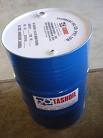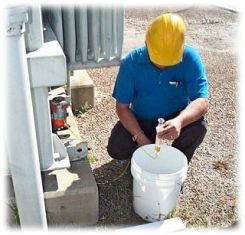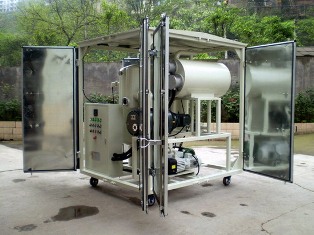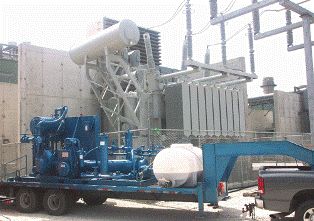Dielectric strength of transformer oils
 One of the main indicators characterizing the insulation properties transformer oils in the practice of their application is their dielectric strength:
One of the main indicators characterizing the insulation properties transformer oils in the practice of their application is their dielectric strength:
E = UNC / H
where Upr — breakdown voltage; h is the distance between the electrodes.
Breakdown voltage is not directly related to specific conductivity, but, like it, very sensitive to the presence of impurities... At the very least, a change in moisture liquid dielectric and the presence of impurities in it (as well as for conductivity) the dielectric strength decreases sharply. Changes in pressure, shape and material of the electrodes and the distance between them affect the dielectric strength. At the same time, these factors do not affect the electrical conductivity of the liquid.
Clean transformer oil, without water and other impurities, regardless of its chemical composition, has a high enough for practice breakdown voltage (more than 60 kV), determined in flat copper electrodes with rounded edges and a distance of 2.5 mm between them. Dielectric strength is not a material constant.
At impact voltages, the presence of impurities has almost no effect on the dielectric strength. It is generally accepted that the failure mechanism for shock (impulse) voltages and long-term exposure is different. With pulsed voltage, the dielectric strength is significantly higher than with a relatively long exposure to voltage with a frequency of 50 Hz. As a result, the risk of switching surges and lightning discharges is relatively low.
The increase in strength with an increase in temperature from 0 to 70 ° C is associated with the removal of moisture from the transformer oil, its transition from an emulsion to a dissolved state and a decrease in the viscosity of the oil.

Dissolved gases play an important role in the degradation process. Even when the strength of the electric field is lower than that of destruction, the formation of bubbles on the electrodes is observed. As pressure decreases for non-degassed transformer oil, its strength decreases.
The breakdown voltage does not depend on the pressure in the following cases:
a) fully degassed liquids;
b) shock stresses (regardless of contamination and gas content in the liquid);
c) high pressure [about 10 MPa (80-100 atm)].
The breakdown voltage of transformer oil is determined not by the total water content, but by its concentration in the emulsion state.
The formation of emulsion water and a decrease in dielectric strength occur in transformer oil containing dissolved water with a sharp decrease in temperature or relative humidity of the air, as well as with mixing of the oil due to desorption of water adsorbed on the surface of the vessel.
When replacing glass in a container with polyethylene, the amount of emulsion water is desorbed when mixing the oil from the surface and increases its strength accordingly. Transformer oil, carefully drained from a glass container (without stirring), has a high electrical strength.
Polar substances with low and high boiling points, forming true solutions in transformer oil, practically do not affect the conductivity and electrical strength. Substances that form colloidal solutions or emulsions of very small droplet size in transformer oil (which are the cause of electrophoretic conductivity), if they have a low boiling point, are reduced, and if their boiling point is high, they practically do not affect the strength.

Despite the huge amount of experimental material, it should be noted that there is still no unified generally accepted theory of the breakdown of liquid dielectrics, applied even under conditions of prolonged exposure to voltage.
The breakdown of impurity-contaminated liquid dielectrics during prolonged exposure to voltage is essentially a shroud gas breakdown.
There are three groups of theories:
1) thermal, explaining the formation of a gas channel as the result of the boiling of the dielectric itself in local places increases field inhomogeneities (air bubbles, etc.)
2) gas, through which the source of decay is gas bubbles adsorbed on the electrodes or dissolved in oil;
3) chemical, explaining the breakdown as a result of chemical reactions occurring in a dielectric under the action of an electric discharge in a gas bubble. What these theories have in common is that oil breakdown occurs in a vapor channel formed by the vaporization of the liquid dielectric itself.
It is hypothesized that the vapor channel is formed by low-boiling impurities if they cause increased conductivity.
Under the influence of an electric field, the impurities contained in the oil and forming a colloidal solution or microemulsion in it are drawn into the area between the electrodes and carried in the direction of the field. A significant amount of released heat in this case, due to the low thermal conductivity of the dielectric, is spent on heating the impurity particles themselves. If these impurities are the cause of the high specific conductivity of the oil, then at a low boiling point of the impurities they evaporate, forming, if their content is sufficient, a "gas channel" in which decomposition occurs.
Evaporation centers can be gas or vapor bubbles formed under the influence of a field (as a result of the electrostriction phenomenon) due to impurities dissolved in the oil (air and other gases, and possibly also low-boiling products of oxidation of a liquid dielectric).

The breakdown voltage of oils depends on the presence of bound water. In the process of vacuum drying of oil, three stages are observed: I — a sharp increase in the breakdown voltage corresponding to the removal of emulsion water, II — in where the breakdown voltage changes little and remains at the level of about 60 kV in standard shock, then time dissolved and weakly bound water, and III — slow growth of decay oil stress by removal of bound water.
